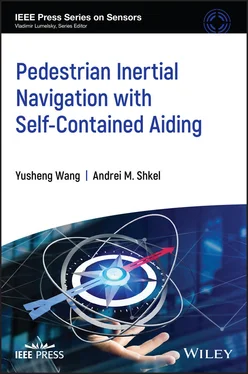In the case of short‐range navigation aiding techniques, Ultra‐Wide Band (UWB) radio, WiFi, Bluetooth, and Radio‐Frequency Identification (RFID) have all been explored. They are typically used in indoor navigation due to their short signal propagation range. Unlike radio‐based navigation, in which the radio frequency is fixed, UWB radio occupies a large bandwidth (  MHz), thus increasing capability of data transmission, range estimation accuracy, and material penetration. WiFi and Bluetooth devices are popular in smartphones, and therefore utilizing them as aiding techniques in indoor navigation does not require any additional infrastructures. RFID has also been proposed due to its low cost for implementation. More recently, 5G and millimeter‐wave communication infrastructure have been explored as a potential source of signals for navigation [27]. For all these aiding techniques, there are two kinds of methods to perform localization: Received Signal Strength (RSS) and fingerprinting. RSS‐based localization algorithm takes advantage of the fact that the strength of the received signal drops as the distance between the source and the receiver increases. Therefore, the strength of the received signal can be used as an indicator of ranging information. Fingerprinting localization algorithm is based on comparing the measured RSS values with a reference map of RSS. Table 1.1summarizes the non‐self‐contained aiding techniques with artificial signals.
MHz), thus increasing capability of data transmission, range estimation accuracy, and material penetration. WiFi and Bluetooth devices are popular in smartphones, and therefore utilizing them as aiding techniques in indoor navigation does not require any additional infrastructures. RFID has also been proposed due to its low cost for implementation. More recently, 5G and millimeter‐wave communication infrastructure have been explored as a potential source of signals for navigation [27]. For all these aiding techniques, there are two kinds of methods to perform localization: Received Signal Strength (RSS) and fingerprinting. RSS‐based localization algorithm takes advantage of the fact that the strength of the received signal drops as the distance between the source and the receiver increases. Therefore, the strength of the received signal can be used as an indicator of ranging information. Fingerprinting localization algorithm is based on comparing the measured RSS values with a reference map of RSS. Table 1.1summarizes the non‐self‐contained aiding techniques with artificial signals.
Table 1.1 Summary of non‐self‐contained aiding techniques.
| Aiding technique |
Applicable area |
Positioning accuracy (m) |
Notes |
| GPS |
Above earth surface |
5 |
Large signal coverage area Unavailable below the Earth's surface and in complex urban areas Susceptible to jamming and spoofing |
| LTE/5G |
Mostly in urban areas |
10 |
No extra infrastructure needed Rely on cellular signal coverage |
| Radar |
In the air |
50 |
Cheap and robust to different weathers Very large effective range Signal can penetrate insulators but will be obstructed by conductive material |
| UWB |
Mostly indoor |
0.01 |
Very accurate distance measurement in a short range Simple hardware with low power consumption Susceptible to interference |
| Lidar |
In the air |
0.1 |
Accurate position and velocity measurement Affected by the weather, such as strong sunlight, cloud, and rain |
| WiFi |
Indoor |
1 |
A priori knowledge of WiFi router is needed Algorithm is needed to compensate for signal strength fluctuations |
| Bluetooth |
Indoor |
0.5 |
Moderate measurement accuracy with very low power hardware Short range of measurement (<10 m) |
| RFID |
Indoor |
2 |
Easy deployment Very short range of measurement |
1.4.2 Self‐contained Aiding Techniques
Another category of aiding techniques is self‐contained aiding. Instead of fusing external signals into the system, self‐contained aiding takes advantage of the system's patterns of motion to compensate for navigation errors. Therefore, self‐contained aiding techniques vary for different navigation applications due to different dynamics of motions.
For example, in ground vehicle navigation, the wheels can be assumed to be rolling without slipping. Thus, IMU can be mounted on the wheel of the vehicle to take advantage of the rotational motion of the wheel. In this architecture, the velocity of the vehicle can be measured by multiplying the rotation rate of the wheel by the circumference of the tire [28]. In addition, carouseling motion of the IMU provides the system more observability of the IMU errors, especially the error of yaw gyroscope, which is typically nonobservable in most navigation scenarios [29]. Besides, low frequency noise and drift can also be reduced by algorithms taking advantage of the motion of the IMU [30].
Another approach is to take advantage of biomechanical model of human gait instead of just the motion of the foot during walking. This approach typically requires multiple IMUs fixed on different parts of human body and relate the recorded motions of different parts through some known relationships derived from the biomechanical model. In this approach, a more accurate description of the human gait is available, through for example, human activity classification and human gait reconstruction. Recognition of gait pattern can help to reduce the navigation error obtained from a single IMU.
Machine Learning (ML) has also been applied to pedestrian inertial navigation. ML has mostly been explored in the field of Human Activity Recognition (HAR) [31], stride length estimation [32], and stance phase detection [33]. However, few studies used the ML approach to directly solve the pedestrian navigation problem. Commonly used techniques include Decision Trees (DT) [34], Artificial Neural Network (ANN) [35], Convolutional Neural Network (CNN) [36], Support Vector Machine (SVM) [37], and Long Short‐Term Memory (LSTM) [38].
Sensor fusion method can be used in a self‐contained way, where multiple self‐contained sensors are used in a single system, and their readouts are fused in the system to obtain a navigation result. For example, self‐contained ranging technique is one possibility. In this technique, the transmitter sends out a signal (can be ultrasonic wave or electromagnetic wave) which is received by the receiver. This technique can be categorized as self‐contained if both the transmitter and the receiver are within the system whose state is to be estimated. For example, in the foot‐to‐foot ranging, the transmitter and receiver are placed on two feet of a person to keep track of the distance between them [24]. In the cooperative localization, ranging technique is applied to measure the distance between multiple agents as a network to improve the overall navigation accuracy of each of the agent [39].
The topic of this book is about the pedestrian inertial navigation and related self‐contained aiding techniques. In Chapter , we first introduce the technological basis of inertial navigation – inertial sensors, and IMUs. Their basic principles of operation, technology background, and state‐of‐the‐art are included. Next, in Chapter , basic implementation and algorithm of strapdown inertial navigation are presented as a basis of the following analysis. Then, we demonstrate how the navigation errors are accumulated in the navigation process in Chapter , with a purpose of pointing out the importance of aiding in the pedestrian inertial navigation. Chapter introduces one of the most commonly used aiding technique in pedestrian inertial navigation: ZUPT aiding algorithm. It is followed by an analysis on navigation error propagation in the ZUPT‐aided pedestrian inertial navigation in Chapter , relating the navigation error to the IMU errors. Chapter presents some of the limitations of the ZUPT‐aided pedestrian inertial navigation, and methods have been proposed and demonstrated to be able to reduce the majority part of the errors caused by the ZUPTs. Chapter discusses efforts in improving the adaptivity of the pedestrian inertial navigation algorithm. Approaches including ML and Multiple‐Model (MM) methods are introduced. Chapter discusses other popular self‐contained aiding techniques, such as magnetometry, barometry, computer vision, and ranging techniques. Different ranging types, mechanisms, and implementations are covered in this chapter. Finally, in Chapter , the book concludes with a technological perspective on self‐contained pedestrian inertial navigation with an outlook for development of the Ultimate Navigation Chip (uNavChip).
Читать дальше

 MHz), thus increasing capability of data transmission, range estimation accuracy, and material penetration. WiFi and Bluetooth devices are popular in smartphones, and therefore utilizing them as aiding techniques in indoor navigation does not require any additional infrastructures. RFID has also been proposed due to its low cost for implementation. More recently, 5G and millimeter‐wave communication infrastructure have been explored as a potential source of signals for navigation [27]. For all these aiding techniques, there are two kinds of methods to perform localization: Received Signal Strength (RSS) and fingerprinting. RSS‐based localization algorithm takes advantage of the fact that the strength of the received signal drops as the distance between the source and the receiver increases. Therefore, the strength of the received signal can be used as an indicator of ranging information. Fingerprinting localization algorithm is based on comparing the measured RSS values with a reference map of RSS. Table 1.1summarizes the non‐self‐contained aiding techniques with artificial signals.
MHz), thus increasing capability of data transmission, range estimation accuracy, and material penetration. WiFi and Bluetooth devices are popular in smartphones, and therefore utilizing them as aiding techniques in indoor navigation does not require any additional infrastructures. RFID has also been proposed due to its low cost for implementation. More recently, 5G and millimeter‐wave communication infrastructure have been explored as a potential source of signals for navigation [27]. For all these aiding techniques, there are two kinds of methods to perform localization: Received Signal Strength (RSS) and fingerprinting. RSS‐based localization algorithm takes advantage of the fact that the strength of the received signal drops as the distance between the source and the receiver increases. Therefore, the strength of the received signal can be used as an indicator of ranging information. Fingerprinting localization algorithm is based on comparing the measured RSS values with a reference map of RSS. Table 1.1summarizes the non‐self‐contained aiding techniques with artificial signals.









